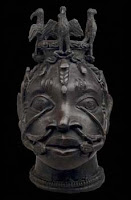Benin Bronzes
Benin HistoryAre a collection of more than 3000[1] brass plaques from the royal palace of the Kingdom of Benin (located in present day Nigeria). They were seized by a British force in the Benin Expedition of 1897 and given to the British Foreign Office. Around 200 of these were then passed on to the British Museumin London, while the remainder were divided among a variety of collections, with the majority being purchased by Felix von Luschan on behalf of the Königliches Museum für Völkerkunde in Berlin (the present-day Ethnological Museum).[2] In 1936, Oba Akenzua II began the movement to return the art now known in modern discourse as the 'Benin Bronzes'.The seizure of Benin art and particularly the "Bronzes" led to a greater appreciation in Europe for African culture.[3] Bronzes are now believed to have been cast in Benin since the thirteenth century, and some in the collection date from the 15th and 16th centuries. Strangely the creation of bronze plaques is thought to have been revived by the arrival of European traders in Benin. The traders brought brass bracelets known asmanillas which were exchanged for spices, ivory or slaves. This metal was melted down and used to create the plaques that decorated the palace in Benin.http://en.wikipedia.org/wiki/Benin_Bronzes
TRADITIONS AND CUSTOMS


.jpeg)

